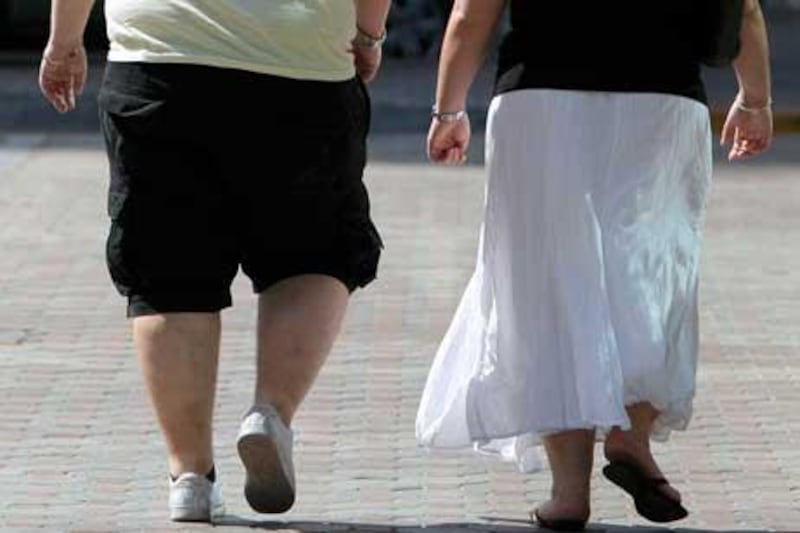In Riyadh, the female receptionist at a gym for women answers the phone with a to-the-point invitation: "Do you want to firm up, slim down, or just get fit?" Regardless of the answer, they have a trainer ready to help. Demand is growing - at one point this year there was a waiting list to join.
This demand may indicate a changing attitude towards fitness in Saudi Arabia, where a new health study puts its population, along with Kuwait and the UAE, among the least physically active in the world.
The British report, published this week by The Lancet medical journal, places Saudi Arabia - where only three of 10 adults meets the study's minimum standard of physical activity - third from the bottom of the 122 countries surveyed.
Kuwait and the UAE, where 64 per cent and 62 per cent of the populations, respectively, are considered inactive, rank seventh and ninth from the bottom. Malta and Swaziland hold the least-active slots.
By comparison, the average country's adult population is about 33 per cent inactive - defined as spending less than two-and-a-half hours exercising with moderate effort, or one hour at high effort, each week.
Richer countries, where technology triumphs over manual labour, tend to have lower rates of activity, the study reported.
In the Gulf, these changes are particularly pronounced and have happened over just a few decades, too quickly for public health officials to respond, said Dr Sudhesh Kumar, a professor at the University of Warwick medical school, who works with the Obesity Research Centre in Saudi Arabia.
"There's [been] a dramatic change in prosperity and, basically, people who used to live in tents and be much more physically active now have dishwashers and maids," he said.
Facilities have not kept up with these dramatic changes, as the overflowing Curves gym in Riyadh suggests. And the climate renders exercise outdoors difficult for several months every year.
The study's authors warn that 1.5 billion people worldwide face "increased risk of coronary heart disease, diabetes, some types of cancer, several other diseases, and premature death", from a lack of exercise.
"Our main message is that physical activity has not been prioritised sufficiently," said Dr Lars Bo Andersen, a co-author of the study. "The health gain we could potentially get [from a] focus on physical activity is enormous."
The Lancet report compares physical activity across countries, using a self-reporting questionnaire intended to limit error by using a combination of words and pictures to help people understand their own level of activity.
The results indicate that there are dramatic differences between regions. While only 17 per cent of South-east Asians are inactive, that average creeps up to 43 per cent in the Americas.
Although this report is among the first to compare exercise prevalence worldwide, related studies on obesity have previously raised concerns about Gulf countries' populations.
About 44 per cent of women in Saudi Arabia are obese, as are 26.4 per cent of men, according to the International Obesity Task Force.
The Health Authority of Abu Dhabi's official 2011 statistics report found that 36 per cent of the population is obese and "without major changes, these rates are set to increase further as the young population ages".
In part because of these alarming figures, public health authorities have redoubled their efforts at prevention and treatment.
In Saudi Arabia, obesity centres have opened at several major universities to study approaches to combating obesity and related chronic conditions, such as diabetes.
The UAE, where 12 per cent of adolescents are estimated to be obese, made physical education mandatory for both public and private schools in 2010.
Still, Dr Tarek Tawfik Amin, a researcher at the University of Cairo, who has conducted studies on obesity rates among Saudi school boys, said that health officials were focusing too much on treatment for conditions such as diabetes and heart-disease, and not enough on prevention.
"They are not fully aware of the problem but they are fully aware of the complications," he said.
Authorities are aware that by 2020, the prevalence of diabetes could reach 60 per cent, he added.
Dr Kumar said that, ultimately, new approaches may also be necessary to address specific needs and cultural understandings of obesity.
"Most people have known for years that the levels [of activity] are low, but there needs to be more research on cultural factors, and how can you change that?" he said, suggesting one possibility could be to encourage the countries' leaders to publicly speak out, rather than trying to educate individuals about exercise.
"What works in the west might not motivate in the Gulf."






